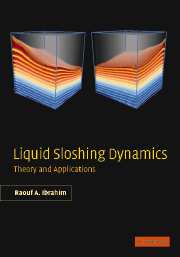Book contents
- Frontmatter
- Contents
- Foreword
- Acknowledgment
- Introduction
- Part I Linear sloshing dynamics
- Part II Nonlinear and parametric sloshing dynamics
- Part III Sloshing – structure interaction
- 8 Linear interaction with elastic containers
- 9 Nonlinear interaction under external and parametric excitations
- 10 Interaction with support structures and tuned sloshing absorbers
- Part IV Rotating fluid and low gravity sloshing
- References
- Index
8 - Linear interaction with elastic containers
from Part III - Sloshing – structure interaction
Published online by Cambridge University Press: 11 August 2009
- Frontmatter
- Contents
- Foreword
- Acknowledgment
- Introduction
- Part I Linear sloshing dynamics
- Part II Nonlinear and parametric sloshing dynamics
- Part III Sloshing – structure interaction
- 8 Linear interaction with elastic containers
- 9 Nonlinear interaction under external and parametric excitations
- 10 Interaction with support structures and tuned sloshing absorbers
- Part IV Rotating fluid and low gravity sloshing
- References
- Index
Summary
Introduction
The problem of dynamic interaction of liquid sloshing with elastic structures may fall under one of the following categories:
Interaction of liquid sloshing dynamics with the container elastic modes in breathing and bending. This type is addressed in this chapter and Chapter 9.
Interaction of liquid sloshing dynamics with the supporting elastic structure. This type is treated in Chapter 10.
Liquid interaction with immersed elastic structures. This class will not be addressed in this book and the reader may consult Chen (1987), Paidoussis (1998) and Dzyuba and Kubenko (2002).
This chapter presents the linear problem of liquid interaction with its elastic container. Two limiting cases may occur where interaction disappears. The first case deals with the excitation of liquid surface modes where significant elastic modes of the container are not participating. In this case, the analysis of liquid dynamics in a rigid container will provide a satisfactory description of the overall behavior. The second case deals with the excitation of the container elastic modes where significant liquid motion does not occur. In this case, the presence of liquid will contribute to the mass distributed to the tank walls, and the analysis can be carried out without considering any interaction with liquid sloshing dynamics.
The first step in studying the interaction of liquid dynamics with elastic tank dynamics is to consider the linear eigenvalue problem and response to external excitations. The coupling may take place between the liquid-free-surface dynamics and with either the tank bending oscillations or breathing modes (or shell modes).
- Type
- Chapter
- Information
- Liquid Sloshing DynamicsTheory and Applications, pp. 481 - 537Publisher: Cambridge University PressPrint publication year: 2005



